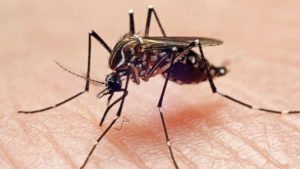Targeting mosquito lipids to inhibit Zika replication
 Viruses such as Zika and dengue are transmitted by the mosquito Aedes aegypti. When the insect bites an infected human host for a blood meal, the virus initially infects the epithelium lining the insect’s midgut and then continues to replicate in multiple tissue types. Eventually the virus is found in the mosquito’s salivary glands and thus the subsequent host is infected upon the next blood meal. A recent study in the journal PLOS Pathogens demonstrates that targeting the mosquito’s sphingolipid pathway may be a means to inhibit viral replication and thus decrease infection of these viruses.
Viruses such as Zika and dengue are transmitted by the mosquito Aedes aegypti. When the insect bites an infected human host for a blood meal, the virus initially infects the epithelium lining the insect’s midgut and then continues to replicate in multiple tissue types. Eventually the virus is found in the mosquito’s salivary glands and thus the subsequent host is infected upon the next blood meal. A recent study in the journal PLOS Pathogens demonstrates that targeting the mosquito’s sphingolipid pathway may be a means to inhibit viral replication and thus decrease infection of these viruses.
The Zika virus is a flavivirus – the family also includes dengue, West Nile and yellow fever. It is a single-stranded RNA virus, first discovered in monkeys in the Zika Forest of Uganda in the 1940s. An African and an Asian lineage have been identified, both normally found in a small equatorial band of the tropics. Since the discovery of Zika, there had been very few human cases until 2007 when an outbreak occurred on Yap Island. However, recent rapid geographic expansion of the Asian lineage has resulted in the spread of Zika virus to a host of countries in Central and South America, as well as to Pacific Island nations.
According to the World Health Organization (WHO), an average of 390 million people are infected with dengue virus annually. Although many have zero or very mild symptoms, between 10,000 and 20,000 people die each year from the disease. Asian and Latin American countries are most affected with dengue, where it is a leading cause of serious illness and death, especially in children.
One of the current avenues to fight mosquito-borne disease is to decrease, eradicate or sterilize the insects. However, according to Dr. Richard Kuhn, a researcher in Purdue University’s Institute of Inflammation, Immunology and Infectious Disease and author of the paper, another strategy to fight viral transmission may be “simply changing the ability of the virus to exploit a pathway and let the mosquito continue on like nothing happened.”
In the mosquito, molecules involved in lipid production and metabolism, which are incorporated into membranes and energy stores, change widely during viral infection. The researchers removed the midgut cells of infected mosquitoes and performed a comprehensive analysis using mass spectrometry. They found metabolites that changed at different points of infection – early, mid and late. During the period of viral replication, there was an increase in lipids in these cells. They identified components of the sphingolipid pathway that were crucial to the replication of the virus. Thus, these molecules are excellent targets to disrupt viral replication and thus transmission of these flaviviruses.
Dr. Caroline Hill, another author on the paper, said, “Control of mosquitoes that transmit diseases to humans is at a crisis point. We currently rely on only four classes of insecticides; resistance to these products is widespread among mosquito populations and we face a very real risk of losing control or being unable to contain disease outbreaks.” Research such as that described here sheds light on new strategies for control and prevention of outbreaks.
Do you work on Zika, dengue or other flaviviruses? Kerafast has a wide range of antibodies to Zika and other infectious diseases.


